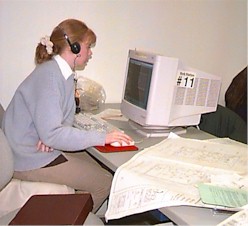
Cornell University Ergonomics Web

Cornell University Ergonomics Web
Martha Van Rensselaer CAD Lab
DEA 651 Class Project
 |
An ergonomic evaluation was undertaken of a computer-aided drafting (CAD) lab at Cornell University. |
Currently, the lab is used by professors and students of interior design, facility planning and management, and textiles and apparel. |
| The study was prompted by user complaints of inadequate and uncomfortable workstations. |  |
A literature review revealed that there are common injuries reported by CAD workstation operators including: |
|
 |
|
 |
This evaluation focused on aspects of workstation design leading to user dissatisfaction, although measures of satisfaction with the ambient environment were also taken in order to identify environmental factors requiring further investigation. Research measures consisted of observation, interviews, and a questionnaire. |
| Responses were received from one
Design and Environmental Analysis professor and a total
of twenty-five students from four courses (two upper
level courses in Design and Environmental Analysis, one
from Textiles and Apparel, and one from the Hotel
school). Questionnaire responses from students in a
similar lab in the Hotel school, which was reportedly
held in higher regard, were included in the study in
order to further isolate factors which may be responsible
for reported dissatisfaction. |
Based on observation of current
workstations and prior research, suggestions are made for
ways to improve current workstation design. These
recommendations include:
|
 |
In light of dissatisfaction expressed by instructors and students with the ambient environment of the CAD Lab, it is recommended that a more in-depth investigation of environmental factors such as air quality, thermal comfort, and lighting be conducted. |
References
Attwood, D. (1989). Comparison of discomfort experienced at CADD, word-processing and traditional drafting workstations. International Journal of Industrial Ergonomics, 4, 39-50.
Hamilton, N. (1996). Source document position as it affects head position and neck muscle tension. Ergonomics. 39(4). 593-610.
Hedge, A., McCrobie, D., Morimoto, S., Rodriguez, S., and Land, B. (1996). Toward pain-free computing. Ergonomics in Design, January, 4-10.
Hedge, A. (1997). (DEA 651: Anthropometrics, Ergonomics, and Biomechanics, Fall 1997. Course notes.) Cornell University, Ithaca, New York.
CUErgo: Cornell's Ergonomics Home Page
This page created by DEA 651: Ergonomics,
Anthropometrics, and Biomechanics,
Send questions or comments to rlp6@cornell.edu.
Last updated January 25, 2009